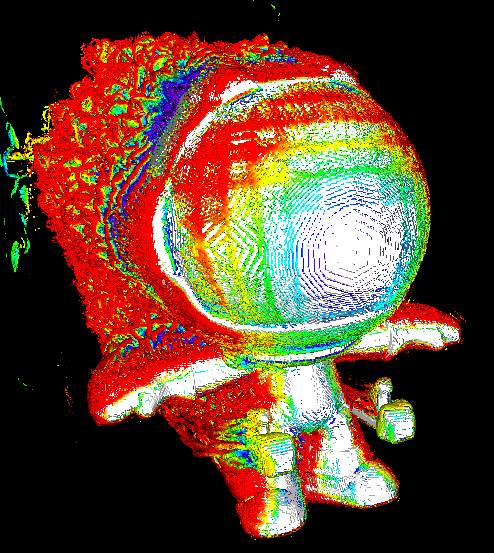IRQ 5, I/O 220, DMA 01 🤘🏻
I was poor, so mine was typically running the “or SoundBlaster compatible” card.
Reading those numbers it’s like I can hear the Duke Dukem intro.
Hail to the king, baby!
Or Star Control 2 Hyperspace theme.
I missed out on that one
“Your sound card works perfectly.”
And if you kept pressing it, it would tell you off. Back when even installers had more soul than their games do now.
Most of the time it was IRQ 7 for me.
Yeah, IRQ7 was also pretty common for sound cards as long as you didn’t need to print at the same time. For DOS games, that wasn’t a big deal but if you were running Windows and multitasking with something that played sound (I was an early adopter of MP3s), you couldn’t use both at the same time.
My first Pentium PC was all kinds of awful because it used that IBM Mwave combo sound card /modem. You couldn’t use the modem and play sound at the same time or it would lock the PC up. It was also configured by default to use IRQ7, so if you were online, you couldn’t print either. At least I was able to work around the latter by setting it to IRQ5.
Ugh…
How did PCs beat out the Amiga, Mac and ST with nonsense like that?
Because I could play the same copies of the same games on my Tandy 1000, the IBM PCs at school, and my friend’s Packard Bell. Standardized architecture was, and still is, a huge draw.
Open and documented APIs.
How did PCs beat out the Amiga, Mac and ST with nonsense like that?
I think you can ultimately blame Compaq. It was the first “pc clone” that showed the market that a PC not from expensive IBM was viable. After that even if you weren’t buying a Compaq your own generic clone was “good enough”. So You could access hardware and software built for a $4000 8088 IBM PC with your $1200 clone.
Amiga never was commodity hardware. It was always expensive. It didn’t get cheap enough fast enough. Amiga 500 came too late.
Volume
What you did there, I see it.
They couldn’t play Doom (until much later). Even to this day, the Amiga ports are lackluster. Hardware wasn’t designed for that kind of game.
Phoenix BIOS/The BIOS Wars
They could play Wolfenstein and Doom…
Sounds poor.
It was the early days of computers, so it’s not like that’s really saying much. Most of it was a mishmash of stuff
deleted by creator
You just unlocked a memory for me. One of my dad’s friends had a super cool keyboard, I think it was a Casio. It had midi, and a bunch of built in instruments. Then he had another friend, who was a huge geek, who figured out how to extract the midi instruments from the keyboard, so we could use them to replace the cheaper sounding midi instruments in windows.
Obviously it didn’t sound as good as the keyboard, because it still was dragged behind by inferior hardware on the PC. Not to mention the fact that some of the instruments just didn’t play, and that Windows liked to crash and revert all instruments back to the default if it didn’t like an instrument we tried to feed it, but I still remember it as something really badass.
most PCs by that time had built-in MIDI synthesizers
Built-in? You had AdLib cards for FM synthesis, but they were never built-in and most PCs didn’t even have them. Adlib cards used the Yamaha OPL2 or OPL3 chip.
Along came Creative Labs with their AWE32, a synthesizer card that used wavetable synthesis instead of FM
You are skipping a very important part here: cards that could output digital audio. The early Soundblaster cards were pioneers here (SB 1.0, SB 2.0, SB Pro, SB16). The SB16 for example was waaaaay more popular than the AWE32 ever was, even if it still used OPL3 based FM synth for music. It’s the reason why most soundcards in the 90s were “Soundblaster compatible”.
Digital audio meant that you could have recorded digital sound effects in games. So when you fired the shotgun in Doom to kill demons, it would play actual sound effects of shotgun blasts and demon grunts instead of bleeps or something synthesized and it was awesome. This was the gamechanger that made soundcards popular, not wavetable.
The wavetable cards I feel were more of a sideshow. They were interesting, and a nice upgrade, especially if you composed music. They never really took off though and they soon became obsolete as games switched from MIDI based audio to digital audio, for example Quake 1 already had its music on audio tracks on CD-ROM, making wavetable synthesis irrelevant.
BTW, I also feel like you are selling FM synthesis short. The OPL chips kinda sucked for plain MIDI, especially with the Windows drivers, and they were never good at reproducing instrument sounds but if you knew how to program them and treated the chip as its own instrument rather than a tool to emulate real world instruments, they were capable of producing beautiful electronic music with a very typical sound signature. You should check out some of the adlib trackers, like AdTrack2 for some examples. Many games also had beautiful FM synthesized soundtracks, and I often preferred it over the AWE32 wavetable version (e.g. Doom, Descent, Dune)
At the time (1995-ish) I was developing a series of Windows applications that let people compose music on their PCs, […] the actual quality of the music when played through a shitty built-in FM sound chip was depressingly awful
And the a Atari ST and Amiga 500 was released in the late 1980s.
deleted by creator
Thanks for the anecdote. I love reading this kind of context-giving stories on how different our expectations on consumer-grade electronics were.
Along came Creative Labs with their AWE32, a synthesizer card that used wavetable synthesis instead of FM.
Creative Labs did wavetable synthesis well before the AWE32 — they released the Wave Blaster daughter board for the Sound Blaster 16, two full years before the AWE32 was released.
(FWIW, I’m not familiar with any motherboards that had FM synthesis built-in in the mid 90’s. By this time, computers were getting fast enough to be able to do software-driven wavetable synthesis, so motherboards just came with a DAC).
Where the Sound Blaster really shined was that the early models were effectively three cards in one — an Adlib card, a CMS card, and a DAC/ADC card (with models a year or two later also acting as CD-ROM interface cards). Everyone forgets about CMS because Adlib was more popular at the time, but it was capable of stereo FM synthesis, whereas the Adlib was only ever mono.
(As publisher of The Sound Blaster Digest way back then, I had all of these cards and more. For a few years, Creative sent me virtually everything they made for review. AMA).
Most of Creative’s AWE32 cards do use a real Yamaha OPL3 chip for FM synthesis, which can produce two-or-four operator voices. The latter of those can approach the quality of the voices in their DX7-family line of musical instruments. Even the older OPL2 chip that is limited to two-operator voices can sound great when programmed well (not that I’d call it realistic-sounding).
The other synth chip on the AWE32 is the Ensoniq EMU8000. That one does sample-based synthesis as you describe above.
Just wanted to note that Creative misappropriated the term wavetable synthesis when they marketed this and other sample-based synthesis cards of theirs, and the misnomer spread widely to the products of other companies and persists to this day.
That was a super interesting read - thanks for the writeup!
Not the same thing, but I still have my old Voodoo 2 3D-accelerator card (not the same thing as a video card back then).
I had the original voodoo 3Dfx in 50lbs Alienware case with a 75 lbs 20+ inch crt… can’t remember the exact size. Wrong choice for university living at the time
VESA local bus. It was the shit and nothing was ever going to be better. Until next year.
I miss my Voodoo 2 3000 AGP card.
I got an ABIT Siluro/ Geforce 2 MX400 after that and Diablo 2 ran worse, the frame rate tanked. I was gutted.
Back in the day I tried to play Morrowind but every time I moved my mouse the game would crash, I started removing hardware until I found out it was my soundcard giving me issues, was an old ISA slot. Got a PCI soundcard after that and no issues.
Those were the days.
Shitty days, but days nonetheless, when PC gaming was the Dark Souls of gaming.
It’s a good thing you held onto it.

Wow, I have a bunch of old stuff laying about too that I figured was worth nothing. Original boxes, games, manuals etc which might help too. Hmm
Shit, I should check my bins
that’s why I sold mine a couple years ago :)
And of course there was a short period of time where a sound card wasn’t required, but would actually improve performance by offloading audio processing to your sound card if you had one. And onboard audio at that time wasn’t great anyways.
You can still get discrete sound cards (both internal and USB), though they’re more for audiophile stuff. With the PS5 touting big 3d audio improvements and HRTFs I half expected manufacturers to make a push to bring them back or at least feature sound features more prominantly in motherboards but I guess CPUs these days can just spare the cycles if you want fancy audio.
Generating music still benefits from offloading to discrete devices though. Like using a synth or multitrack stuff.
Modern CPUs can do all the audio processing you’d ever need (maybe barring some professional use cases like making music or editing a movie).
Audiophile external audio devices are just doing the conversion from a digital signal to an analogue signal.
Oh god AC97 era onboard audio was just bad, there was always weird glitchy sounds coming from interference elsewhere on the motherboard
Or when your mobile phone was about to ring.
That one was actually down to poorly insulated speakers and 2G phone signals dipping into the audible frequency range
And the mind blowing difference in midi quality if you heard the upgrade the first time…
And of course there was a short period of time where a sound card wasn’t required, but would actually improve performance by offloading audio processing to your sound card if you had one
we are at this point in history, but for graphics cards :)
I’ll give you 4 characters: 3dfx.
Not in the same way, as you aren’t using the integrated gpu at all if you get an external one. I guess if you’re talking about shared ram this makes sense though.
I seem to recall the integrated sound wasn’t used either, when I had my sound card in - the audio connectors were going directly into the sound card.
yea, IDK how it works as I’ve never had a computer back then, but the quoted reply makes it sound like getting a sound card would take load off of the CPU.
oh - my apologies, I forgot that on-board graphics have a dedicated chipset. Also, no idea whether on-board sound would have used CPU power back in the late days of soundcards, as the comment I responded to was claiming… might have been a sound chip for that, too…
I remember Battlefield 2 being a prime example for that. Not only did its performance improve once I added a discrete sound card, it also sounded much better.
I bought an X-Fi card just for that game.
Grandpa said nothing wrong.
The company name was Creative Labs.

I inferred that the “…” meant he was still talking and his granddaughter interrupted him
deleted by creator
Plug and pray
deleted by creator
Wait, he didn’t even get to the part where you had to configure it!!
IRQ 5?
I thought 7 was the magic number
You’re both right! It started as 7 for the default and changed to 5 because 7 was also the default for the parallel port.
Seriously. And they also didn’t cover the part where the damn driver would randomly get corrupted every now and then
I have fond memories of these simpler times…
“The planet Arrakis, known as Dune”
My very first experience with a sound card was watching the Dune 2 intro on my dad’s friend’s computer. I was so amazed, I just sat in awe as that intro movie played.
On the drive home I tried to remember if what I heard was real, and I just couldn’t imagine it. When I tried to recall what I saw and heard, I could only imagine hearing that tinny internal speaker making bleeps and bloops instead of the actual sounds. It just seemed so unreal at the time that I could not recall what I had heard only a few hours earlier :)On a side note, I don’t think any studio in the nineties made as memorable tunes and sounds as Westwood did. There was always something enchanting about them. Dune 2, the Kyrandia games, they all had excellent music that really played into the strengths of what was available back then.
Of course I’m talking with pink tinted nostalgia goggles, but still… good memories :)Great, now I have the ornithopter theme from Dune 1 stuck in my head.
Ah the sweet sounds of a simpler, worryfree time …
Frank Klepacki, what a fucking gem.
At the same time, the Commodore Amiga had built-in stereo 44.1kHz 16-bit sound…
Magnificent machine. I loved mine so much for so many years.
I even played Doom and Doom 2 on mine, at some horrendously low resolution.
8 channels (if they cheated a bit)
Originally 28 kHz 8-bit.
https://amitopia.com/amiga-was-already-capable-of-14bit-playback-in-1985/
I don’t think that’s accurate… Of course it’s possible I’m misremembering something from 35+ years ago, but there’s no performance benefit for 14 bits over 16- either way, it’s a 2-byte fetch, you don’t save anything by leaving off two bits. So I’d almost believe it was 8-bit rather than 16, but the difference in sound quality is huge, and the Amigas had a 16-bit data bus so 16-bit fetches took no more effort than 8-bit. The sample rate I’d be more likely to believe I had wrong, but again, there are technical reasons for the 44.1 kHz rate that have to do with recording digital audio to videotape, so I could see it being half that, but not some random number. But again, huge sound quality difference between 44.1 and 22.05.
All that said, I’m not too familiar with the 1000, I had the 500 which was basically the same machine as the 2000 but in a more compact case. My uncle had a 1000, but he used it professionally so he wouldn’t let me near it :D
The C=64 SID was even further ahead of its time
How quickly we forget the chip tunes of the PC Speaker, I used it in a computer lab one day to play a nearly undetectable high freq wave using logo. The PC Speaker was a pretty flexible little speaker
I used the Amiga disk drive to play music. It sounds like you would imagine. And will destroy the drive if you play too much.
Nice I couldn’t imagine playing music on my c64’s 1541 drive the thing made scary knocking noises when it worked properly!
The c64 could do all sorts of music over the TV speakers, even voices. Who can forget Impossible Mission “Another visitor, stay a while, stay forever!”
That laugh still haunts me. Also the SAM application for text to speech which was pretty good for the era
Flexible enough that Access Software built a library called RealSound that could do 6-bit PCM audio over it. Which isn’t great but is dramatically better than you’d expect. A bit over a dozen or so games used it.
I had one called Mean Streets that used it for things like voice. The game came with instructions for how to build a cable to connect your internal speaker to an RCA cable to run to a stereo or similar.
Oh man that unlocked a memory of some attempts I heard of voices through PC Speaker that weren’t bad but definitely weren’t great lol
SET BLASTER=A220 I5 D1 H5 P330 T6
Failed. IRQ currently in use.
Too real :D
Fuck Creative. Letigious patent troll is the whole reason why 3D audio in games was stuck in the dark ages technologically for the longest time.
Miss that era and wish that there were more options for PCI “premium” sound cards. All of the fancy DACs and audio interfaces are seemingly USB.
The inside of the PC is electrically hostile to good sound quality. Loads of electrical noise.
USB is an excellent use of a sound interface.
i had an internal creative soundcard some 5 years back. sound was pretty perfect with dt990 pro and sz2000. my current creative usb soundcard has more noise :(
What if I put foil all around it
You’d have to put it all the way around it, including near the connector. Obviously you can’t put it inside the connector, but that’s another avenue for noise to get in. Outisde the box of noise with it’s own box of insulation is a much calmer place.
And then three things happened at once
- Creative de-facto monopolized the industry often by unethical means (suing Aureal into bankruptcy, etc.), not letting much room for competitors, which in turn lead to diminishing quality on the part of Creative.
- Microsoft didn’t put hardware acceleration support into XAudio, which superseeded DirectSound.
- Game publishers realized the vast majority of gamers didn’t care about sound quality, so they could spent those resources on making the games look a little bit more realistic.
























